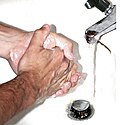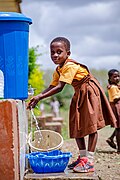Hand washing
Hand washing is a crucial practice in maintaining personal hygiene and preventing the spread of diseases. It involves the use of water and soap to clean the hands, and is considered one of the most effective ways to prevent the spread of pathogens and infections.
Overview[edit]
Hand washing is a simple yet vital behavior in hospitals and other healthcare settings. It can prevent the spread of many diseases, including the common cold, flu, and other viral and bacterial infections. The World Health Organization (WHO) and the Centers for Disease Control and Prevention (CDC) recommend washing hands with soap and water as the best way to get rid of germs in most situations.
Importance[edit]
Hand washing is important because it's the first line of defense against the spread of many diseases. From the common cold to more serious infections such as meningitis, bronchitis, influenza, hepatitis A, and many types of diarrhea, hand washing can prevent the spread of a variety of pathogens.
Technique[edit]
The correct hand washing technique is important to ensure all parts of the hands are cleaned. This includes the palms, back of the hands, wrists, between the fingers and under the fingernails. The process should take at least 20 seconds, and involves five steps: wet, lather, scrub, rinse and dry.
Hand Sanitizers[edit]
When soap and water are not available, hand sanitizers can be used as an alternative. They are not as effective as hand washing in removing all types of germs, but they can quickly reduce the number of germs on hands in many situations.
See Also[edit]
References[edit]
<references />
|
|
|
-
Hand washing
-
Stop microbes wash your hands
-
Supervising a young boy washing his hands
-
Hand cleaning
-
Hand disinfection
-
Pupil washes hands during COVID-19 pandemic in Ghana
-
A nurse uses a smart hand washing device
-
In Rwanda build where everyone can wash hand in prevention of COVID-19
-
Hand washing
-
Hand desinfection test with blood agar plate
-
Proportion of population with basic handwashing facilities on premises
-
Hand washing comic
Ad. Transform your life with W8MD's Budget GLP-1 injections from $75


W8MD offers a medical weight loss program to lose weight in Philadelphia. Our physician-supervised medical weight loss provides:
- Weight loss injections in NYC (generic and brand names):
- Zepbound / Mounjaro, Wegovy / Ozempic, Saxenda
- Most insurances accepted or discounted self-pay rates. We will obtain insurance prior authorizations if needed.
- Generic GLP1 weight loss injections from $75 for the starting dose.
- Also offer prescription weight loss medications including Phentermine, Qsymia, Diethylpropion, Contrave etc.
NYC weight loss doctor appointmentsNYC weight loss doctor appointments
Start your NYC weight loss journey today at our NYC medical weight loss and Philadelphia medical weight loss clinics.
- Call 718-946-5500 to lose weight in NYC or for medical weight loss in Philadelphia 215-676-2334.
- Tags:NYC medical weight loss, Philadelphia lose weight Zepbound NYC, Budget GLP1 weight loss injections, Wegovy Philadelphia, Wegovy NYC, Philadelphia medical weight loss, Brookly weight loss and Wegovy NYC
|
WikiMD's Wellness Encyclopedia |
| Let Food Be Thy Medicine Medicine Thy Food - Hippocrates |
Medical Disclaimer: WikiMD is not a substitute for professional medical advice. The information on WikiMD is provided as an information resource only, may be incorrect, outdated or misleading, and is not to be used or relied on for any diagnostic or treatment purposes. Please consult your health care provider before making any healthcare decisions or for guidance about a specific medical condition. WikiMD expressly disclaims responsibility, and shall have no liability, for any damages, loss, injury, or liability whatsoever suffered as a result of your reliance on the information contained in this site. By visiting this site you agree to the foregoing terms and conditions, which may from time to time be changed or supplemented by WikiMD. If you do not agree to the foregoing terms and conditions, you should not enter or use this site. See full disclaimer.
Credits:Most images are courtesy of Wikimedia commons, and templates, categories Wikipedia, licensed under CC BY SA or similar.
Translate this page: - East Asian
中文,
日本,
한국어,
South Asian
हिन्दी,
தமிழ்,
తెలుగు,
Urdu,
ಕನ್ನಡ,
Southeast Asian
Indonesian,
Vietnamese,
Thai,
မြန်မာဘာသာ,
বাংলা
European
español,
Deutsch,
français,
Greek,
português do Brasil,
polski,
română,
русский,
Nederlands,
norsk,
svenska,
suomi,
Italian
Middle Eastern & African
عربى,
Turkish,
Persian,
Hebrew,
Afrikaans,
isiZulu,
Kiswahili,
Other
Bulgarian,
Hungarian,
Czech,
Swedish,
മലയാളം,
मराठी,
ਪੰਜਾਬੀ,
ગુજરાતી,
Portuguese,
Ukrainian













